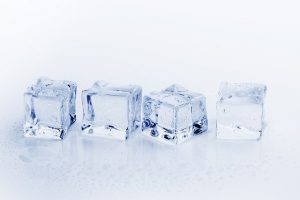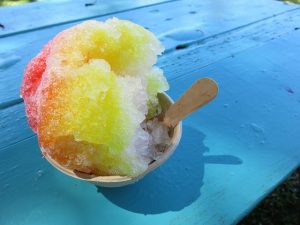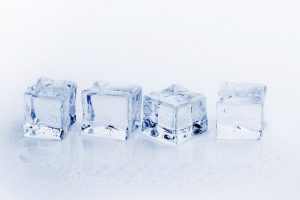Welcome to our article all about different types of ice! We’ll go through the pros and cons of the 9 most common types of ice a bit further down this article, but first, let’s discuss why you might want to consider one type of ice over another in the first place.
Contents
Types of Ice – Introduction
The subject of ice is not as simple as it may seem, and at times it can be a bit confusing.
Sure, all ice can cool down your drink, but with the increasing demand for ice in the hospitality, commercial and domestic industries, it is not just about frozen water anymore. It is now more about how ice can best serve your needs, whatever they may be.
Ice nowadays comes in different types and each one serves a specific purpose.
There is ice made for cooling drinks, for product presentations, for food preservation, and even solely for chewing on.
Each type of ice has different characteristics that make it suitable for one application or use over another.
The most common use for ice is still in serving drinks or food displays, and if you want that extra wow factor for your bar, restaurant or market stall, a little knowledge of the different types of ice out there can help you improve your customer’s experience dramatically.
Below we will go through the 9 most common types of ice, discussing not only their shapes and unique characteristics, but also the best scenarios to use them in to help you get the most out of your ice.
The 9 Most Common Types of Ice Are:
Here is a quick list of the most common types of ice typically used in the home, commercial and hospitality industries:
- Regular Cube Ice
- Full Cube Ice
- Half Cube Ice
- Spherical Ice
- Gourmet Ice
- Crescent Ice
- Nugget Ice
- Flaked Ice
- Crushed Ice
Types of Ice – Quick Comparison
Here is a quick summary table so that you can easily compare different types of ice side by side. Below we have included information such as other names that types of ice may be known by, it’s typical shape, melt rate and best uses.
All this information has also been repeated at the bottom of each ice description so you won’t have to keep scrolling back up to this table to remind yourself!
If you’re on mobile, scroll across the table with your finger!
Detailed Descriptions of Each Type of Ice
Regular Cube Ice

Regular cube ice is probably the most common type and the standard one that most ice makers produce. It is a solid block of ice that is roughly square-shaped on one end but slightly tapered on the other end. It typically has rounded corners and measures approximately 1 1/8” x 1 1/8” x 7/8”.
Regular cube ice is what you usually make at home using your old-fashioned ice trays in freezers. Commercially, though, one issue with this type of ice is that it takes up more water and energy to produce compared to other types because its large size takes longer to freeze.
- Also known as: Large Cube
- Typical shape: Cube
- Melt rate: Slow
- Best used for: Ice retailing, ice dispensing, soft drinks, mixed drinks
Full Cube Ice
Full cube ice is an all-purpose ice. It has a compact shape and build, usually made with a 100% ice-to-water ratio. It is suitable for keeping food cold in your cooler when you are on the go. Its uniform shape and larger size make it great for cooling drinks or food while reducing it’s melt time.
It is also the type of ice that you normally encounter in your drinks at restaurants, hotels, and convenience stores.
- Also known as: Dice Ice or Square Cube
- Typical shape: Rhomboid
- Melt rate: Slow
- Best used for: Bagged ice, bulk cooling
Half Cube Ice
Half cube ice is, well, half the size of the full cube, making it smoother and nicer to chew because of its compact size. It measures an average of 7/8” x 7/8” x 7/8”. Its smaller size means that more ice can fit in a glass, which means less of the beverage is needed, that is why it is also the type usually found in restaurants, convenience stores, and commercial kitchens.
- Also known as: Half Dice or Small Cube
- Typical shape: Rhomboid
- Melt rate: Medium
- Best used for: Carbonated drinks, mixed drinks
Spherical Ice
Spherical ice is ice shaped like a sphere or a round ball. It is quickly gaining popularity because a sphere has a lot less surface area compared to a cube, allowing it to cool drinks without watering them down.
Spherical ice is becoming more frequently chosen over ice cubes, especially among bartenders and mixologists. The spherical shape fits into majority of cocktail glasses, including double old-fashioned, martini, rock, and wine glasses. Plus, the unusual shape adds that extra layer of sophistication to a drink!
- Also known as: Ice balls
- Typical shape: Sphere or ball
- Melt rate: Slow
- Best used for: Straight drinks such as bourbon, rye, Scotch, Irish whiskey etc.
Gourmet Ice
Gourmet ice is clear and hollow ice that is shaped to prevent splashing when drinks are poured over it. It is usually the ice of choice for long and elegant events such as banquets and weddings.
It is a clear and dense type that melts exceptionally slowly, allowing you to enjoy the taste of your drinks for a long time without them becoming diluted.
Making gourmet ice involves using water with 98% purity and freezing it in customized molds for 48 hours. Not only is it for high-end applications, but making it is also a high-end process. This means that most gourmet ice makers are commercial grade.
- Also known as: Top Hat Ice
- Typical shape: Octagon
- Melt rate: Slow
- Best used for: Cocktails and drinks on the rocks
Crescent Ice
Crescent ice is also a popular choice and is gourmet ice’s smaller and more economical cousin. It is dense and solid but may not be as crystal clear as other types. Its unique shape prevents them from sticking to each other, making them float freely in drinks and evenly cooling them.
Its half-moon shape also prevents drinks from splashing out as you pour them over the ice. It is also typically hard so it is not an ideal type to use in blenders.
- Also known as: Half Moon Ice
- Typical shape: Half-moon
- Melt rate: Slow
- Best used for: Mixed drinks, soft drinks, ice bagging, ice dispensing
Nugget Ice
Nugget ice, or more popularly known as Sonic ice, was introduced by the fast-food restaurant years ago. At first, it was just available in their drinks, but it soon became so popular that they started selling it in bags. Today, there are ice makers available that make nugget ice so you can even enjoy it at home.
Nugget ice tends to absorb the flavor of drinks very well, which, aside from being extremely chewable, is another reason it shot to ice fame in the first place. It also melts slower because of the way it is made.
Nugget ice is small, irregular, and cylindrical pieces of ice that is produced very similar to flake ice. It starts as frost on the inside of a cylinder and is then scraped together using an auger. The difference is that the ice is then forced through a tube, and a machine at the end of that tube slices the tube of ice into somewhat uniformly sized nuggets.
- Also known as: Pebble Ice, Pellet Ice, or “Sonic” Ice
- Typical shape: Cylinder
- Melt rate: Slow
- Best used for: Soft drinks, blended drinks such as smoothies and frozen cocktails, chewing
Also Read: Best Nugget Ice Makers
Flake Ice
Flake ice is a soft, moldable form of ice that has a texture very similar to snow. Its unique texture plus soft consistency makes it perfect for instances where items can’t be damaged or scratched, such as food displays and food transport.
It is also beneficial in medical injuries and ailments. It is especially helpful for patients who want a cold drink but whose physical condition prevents them from taking fluids by mouth too quickly. The idea is to put the ice in their mouth, and they gradually take in the water as the ice melts. Flake ice is also great for ice packs for sports-related injuries.
It is made by spraying water on the inside of a cylinder where it freezes into thin layers. Rotating blades chop the thin layers into flakes which then fall onto a storage bin where it will be shaped and packed.
- Also known as: Shaved ice
- Typical shape: Flakes
- Melt rate: Fast
- Best used for: Blended drinks, frozen desserts, food display, medical ice packs
Also Read: Hawaiian Shaved Ice Machines
Crushed Ice

Crushed ice is simply ice cubes that have been crushed either finely or coarsely. Since it has more surface area than an ice cube, it tends to cool things faster. The downside is it also melts faster and can dilute drinks quickly which can render them somewhat tasteless. It is also the type of ice used to pack around a drum for making ice cream.
Crushed ice can be made with either a hand-cranked ice crusher or an electric one. However, there is no denying the fact that pounding ice cubes with a mallet inside a Ziploc bag also works quite well (and is a lot of fun!)
- Also known as: N/A
- Typical shape: Tiny droplets or particles
- Melt rate: Fast
- Best used for: Some cocktails such as juleps, tiki drinks, or cobblers, and snow cones
Types of Ice – Conclusion
As you can see, there is a specific kind of ice for every need and application.
If you’re making yourself a soda or want to cool down food, go with cube ice.
If it’s drinks time and you want something special for your whiskey or scotch on the rocks, try a spherical ice ball.
If you want ice to chew on, nugget ice is the best by far.
If you need ice for your fresh sea food platter, go with flaked ice.
And if you want a delicious summer snow cone treat, crushed ice is for you!
Hopefully you’ve enjoyed reading this article and it’s helped you learn all about the many and varied types of ice available.
Here are some related articles you may also enjoy:
Snow Cones vs Shaved Ice
Best Hawaiian Shaved Ice Machines

Hi there, I’m Richard Parker! I own two food truck businesses in Hawaii, selling snow cones, gelatos and frozen drinks. I’ve been working with ice makers for most of my professional career, and created this website to pass on my knowledge. I hope you enjoy!

Leave a Reply